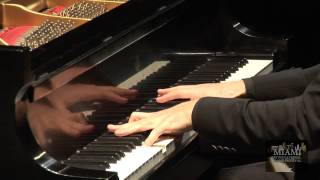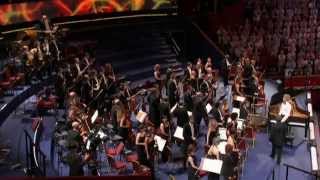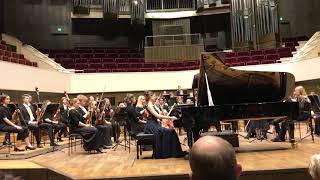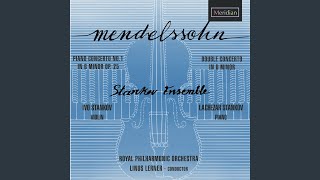Friday, 28 November, 2025г.
















Где искать: по сайтам Запорожской области, статьи, видео ролики
пример: покупка автомобиля в Запорожье
Ponte Singers and Orchestra 2014 :Piano Concerto in A minor (Clara Schumann) by Karen Sung
2014 Ponte Singers Concert - Star-crossed 「錯.愛」(Hong Kong)
Presented by:Ponte Singers and Orchestra
演出者:Ponte Singers and Orchestra
Soloist: Ms Karen Sung
鋼琴獨奏:宋可樟小姐
Conductor:Mr Stephen Lam Lik Hin
指揮:林屴汧先生
Venue :Jehovah-jireh Concert Hall, International Christian Quality Music Secondary and Primary School
場地 :國際基督教優質音樂中學暨小學以勒音樂廳
克拉拉.舒曼:A 小調鋼琴協奏曲
這是克拉拉唯一一首傳世且完整的鋼琴協奏曲,寫於她13歲的時候,可以說是十分青澀的作品,所有的格式緊隨著十九世紀三十年代的風格。當時她在嚴父的訓練及宣傳下,已經是歐洲薄有名氣的年輕鋼琴家,並不時在自己的獨奏會上彈奏自己的作品。
協奏曲原本的格局只有一個樂章,當時羅拔.舒曼和克拉拉已經相識,羅拔的名氣大不如克拉拉,不過他亦主動提出協助克拉拉把這個樂章 (後來的第三樂章) 編成管弦樂的編制 (簡稱配器),與其說這樂章聽起來似是羅拔的風格,倒不如說似是學蕭邦的風格。
後來克拉拉跟從傳統的協奏曲三個樂章的格局,完成了第一和第二樂章的獨奏和配器,首演是由另一位著名德國作曲家孟德爾遜指揮,就在孟德爾遜家族擁有的萊比錫布業大廳 (到今天,萊比錫布業大廳管弦樂團仍是歐洲首屈一指的樂團),獨奏的當然是克拉拉本人。
也許是出自一位鋼琴家的手筆,這首協奏曲與其說是像傳統協奏曲般充滿著鋼琴和樂隊的交錯對話,這首A小調鋼琴協奏曲更像一首鋼琴獨奏曲,當中不乏類似即興演奏的炫技樂段,可以說是十分另類的作曲手法。第一樂章以嚴肅的步操風格開始,接著的一段鋼琴的華麗樂段,相當攝人,後來的挪威作曲家葛利格 (Grieg) 的鋼琴協奏曲也是取材於此。音樂中段較開首輕盈,但優美的旋律中仍透有苦澀,這鋼琴樂段明顯受到蕭邦風格的影響。第一樂章的結尾由樂團帶領,直接進入第二樂章。第二樂章是一段鋼琴獨奏與大提琴獨奏,在傳統的協奏曲是少有的編制,樂章開頭的風格標記「Romanze」表明了整個樂章浪漫抒情的風格,並以簡單動人的旋律貫穿其中。第三樂章是整首歌最長的樂章,正如前段所說,帶有像蕭邦的波蘭舞曲(Polonaise)的味道,主題不斷的以不同手法變奏,令整個樂曲的結構有點含糊不清。
Clara Schumann: Piano Concert in a minor
Clara Schumann began writing the only Piano Concerto that was then completed and published at the age of 13. Its form strictly conformed to the style of the 1830’s. Thanks to her father’s rigorous training as well as publicity work, the fame of Clara as a young pianist began to emerge. She often performed her own compositions during recitals as well.
The concerto was originally structured as a one-movement work. Evidently the fame of Schumann, having already acquainted with Clara, was not comparable to hers at that point. Still, he took the initiative to orchestrate the movement she wrote, which then became the third movement performed tonight. Rather than the Schumann style one may anticipate, the outcome is somewhat resembling that of Chopin.
After that, Clara completed the first and second movement – both solo and tutti parts – all on her own. The premiere was held in the Gewandhaus (base of Leipzig Gewandhaus Orchestra, an all-time leading orchestra in Europe). The conductor of this premiere is Felix Mendelssohn, whose family possessed the concert hall, and the soloist is nobody else but Clara.
The A minor Piano Concerto is more or less like a solo piano work than any dialogues-filled concerto, most likely because the composer herself is a virtuosic pianist. The improvisational sections are somewhat unorthodox at that time. The first movement opens with solemn marches, followed by a glamorous, stunning passage played by piano (Norwegian composer Grieg also made reference to this in his Piano Concerto). Slight bitterness seeps into the lighter middle section, approving the influence of Chopin. The orchestra linked the ending of first movement seamlessly to the second movement, essentially a duo of piano and cello. A simple yet graceful melody run through the movement titled “Romanze”. Occupying the largest portion, the third movement exhibits features of Chopin’s Polonaise. The evolving variations of the theme, however, blur the structural focus of the concerto as a whole.
Теги:
Concerto (Composition Type) Piano (Musical Instrument) Music Education (Field Of Study) clara clara schumann schumann piano concerto piano concerto A minor Cocnerto in A minor Karen sung karen stephen lam stephen hinhin lam 林屴汧 宋可樟 克拉拉 協奏曲 鋼琴協奏曲 A 小調鋼琴協奏曲 國際基督教優質音樂中學暨小學以勒音樂廳 以勒音樂廳 Jehovah-jireh Concert Hall International Christian Quality Music Secondary and Primary School Ponte Singers Ponte Ponte Singers and orchestra orchestra 錯.愛 star-crossed
Похожие видео
Мой аккаунт


 У вашего броузера проблема в совместимости с HTML5
У вашего броузера проблема в совместимости с HTML5


